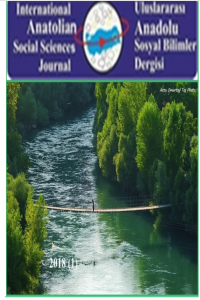TARİHSEL/TOPLUMSAL TRAVMALARIN KUŞAKLARARASI PSİKOSOSYAL ETKİLERİ: DERSİM 38 ÖRNEĞİNDE BİR OLGU SUNUMU
Kuşaklararası Aktarım, Ruh Sağlığı, Toplumsal travma, Tertele, Dersim 38
INTERGENERATIONAL PSYCHOSOCIAL EFFECTS OF HISTORICAL/SOCIAL TRAUMA: A CASE REPORT IN DERSIM 38 EXAMPLE
Kuşaklararası Aktarım, Ruh Sağlığı, Toplumsal travma, Tertele, Dersim 38,
___
- Arslan,Y. (2022). 38, Travma İyileşme, ve Annemin Yüzyılı. İstanbul: Kalan Yay.
- Bombay, A., Matheson, K., Anisman, H.(2009). Intergenerational Trauma: Convergence of Multiple Processes among First Nations peoples in Canada Journal of Aboriginal Health. J Aborig Health, 5(3), s.6-47.
- Chaumette, B., Kebir, O., Mam Lam Fook, C., Bourgin, J. ve diğerleri (2016) Stress and psychotic transition: A literature review. Encephale. 42(4), s. 367-73, doi: 10.1016/j.encep.2015.10.001.
- Dekel, R., Goldblatt, H. (2008). Is there intergenerational transmission of trauma? The case of combat veterans’ children. Am J Orthopsychiatry, 78: s.281-289.
- Dunn, G.E., Ryan, J.J., Dunn, C.E. (1994). Trauma symptoms in substance abusers with and without histories of childhood abuse. Journal Psychoactive Drugs, 26, s. 357-360.
- Greenblatt-Kimron, L., Shrira, A., Rubinstein, T., Palgi, Y. (2021). Event centrality and secondary traumatization among Holocaust survivors' offspring and grandchildren: A three-generation study. J Anxiety Disord., 81:102401. doi: 10.1016/j.janxdis.2021.102401.
- Herman, J. (2011). Travma ve İyileşme: Şiddetin Sonuçları-Ev İçi İstismardan Siyasi Teröre T. Tosun (Çev.). İstanbul: Literatür Yay.
- Hirschberger, G.(2018). Collective Trauma and the Social Construction of Meaning. Front Psychol., 9, s.1441.
- Karatay, G., Günderci, A., Demir, M.C., Gürarslan Baş, N., Çevik, Y.(2017). The Psychotraumatıc Effects of 'Dersim 38' On The Second And Thırd Generatıon. Academic Research International, 8(2), s.78-88
- Karatay, G. (2021). Epidemiyolojik Araştırma Yöntemleri. Sağlık Disiplinlerine Özel Temel Epidemiyoloji. Ankara:Eğiten Kitap.
- Kellerman, N.P.(2001). Psychopathology in children of Holocaust survivors: a review of the research literature. Isr J Psychiatry Relat Sci., 38, s.36.
- Lochner, C., du Toit, P.L., Zungu-Dirwayi, N et all.(2002). Childhood trauma in obsessive-compulsive disorder, trichotillomania, and controls. Depression and Anxiety, 15(2), s. 66-68.
- MacMillan, H.L., Fleming, J.E., Streiner, D et al.(2001). Childhood abuse and lifetime psychopathology in a community sample. Am J Psychiatry, 158, s.1878-1883
- O’Neill, L., Fraser, T., Kitchenham, A., et all. (2016). Hidden burdens: A review of intergenerational, historical and complex trauma, implications for indigenous families. Journal of Child & Adolescent Trauma, 11(2), s.173-186.
- Bjornsson, A.S., Hardarson, J.P., Valdimarsdottir, A.G., Gudmundsdottir, K., Tryggvadottir, A., Thorarinsdottir, K., … Thorisdottir, A.S. (2020). Social trauma and its association with post-traumatic stress disorder and social anxiety disorder. Journal of Anxiety Disorders, 72, 102228.
- Ramo Fernández, L., Schneider, A., Wilker, S., Kolassa, I.T. (2015). Epigenetic alterations associated with war trauma and childhood maltreatment. Behavioral Sciences and the Law, 33(5), s.701-721.
- Salberg, J.(2015). The texture of traumatic attachment: presence and ghostly absence in transgenerational transmission. Psychoanal Q, 84(1), s. 21-46.
- Tahka, V (1984). Dealing with object loss. Scandinavian Psychoanalytic Review, 7 (1), s.13-33.
- Toledo, P. (2014). Transgeneratıonal Trauma: Autonomy, Anger and Somatization Between Children of Traumatızed and Non– Traumatızed Parents (Unpublished Phd Thesis), Bahçeşehir University, Istanbul.
- Volkan, D.V. (2001). Massive Shared Trauma and “Hot” Places. Lucy Daniels Foundation Conference, Chapel Hill, North Carolina. (Erişim Tarihi: 20.03.2023): https://www.researchgate.net/publication/323769209_Massive_Shared_Trauma_and_Hot_Places
- Başlangıç: 2017
- Yayıncı: Yusuf ARSLAN
SEYYİD YAHYÂ-YI ŞİRVÂNÎ’NİN SEYR U SÜLÛK ANLAYIŞI
DÖVİZ KURU İSTİKRARSIZLIĞININ KAYNAKLARI: TÜRKİYE İÇİN ZAMANLA DEĞİŞEN NEDENSELLİK YAKLAŞIMI
ORTAOKUL ÖĞRETMENLERİNİN OKULDA KARŞILAŞTIKLARI STRES KAYNAKLARI ÜZERİNE BİR ARAŞTIRMA: HATAY ÖRNEĞİ
Mehmet ÇOLAK, Cuma Ali YÜKSELEN, Mehmet DOĞRU
HAVACILIK YÖNETİMİ ÖĞRENCİLERİNİN REZERVASYON SİSTEMİNE İLİŞKİN ALGILARI: METAFOR ANALİZİ ÖRNEĞİ
Murat Ahmet DOĞAN, Zafer ŞİMŞEK, Asena AYVALIOĞLU
SİVİL HAVACILIK ÖĞRENCİLERİNİN KÜLTÜRLERARASI İLETİŞİMSEL YETERLİLİĞİNİ ÖLÇMEYE YÖNELİK BİR İNCELEME
